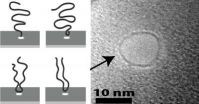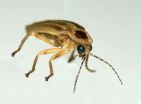(Press-News.org) Researchers at UCLA say it's not just what you eat that makes those pants tighter — it's also genetics. In a new study, scientists discovered that body-fat responses to a typical fast-food diet are determined in large part by genetic factors, and they have identified several genes they say may control those responses.
The study is the first of its kind to detail metabolic responses to a high-fat, high-sugar diet in a large and diverse mouse population under defined environmental conditions, modeling closely what is likely to occur in human populations. The researchers found that the amount of food consumed contributed only modestly to the degree of obesity.
The findings are published Jan. 8 in the online edition of the journal Cell Metabolism and will appear Jan. 9 in the print version.
"Our research demonstrates that body-fat responses to high-fat, high-sugar diets have a very strong genetic component, and we have identified several genetic factors potentially regulating these responses," said first author Dr. Brian Parks, a postdoctoral researcher at the David Geffen School of Medicine at UCLA. "We found that obesity has similar genetic signatures in mice and humans, indicating the mice are a highly relevant model system to study obesity. Overall, our work has broad implications concerning the genetic nature of obesity and weight gain."
The dramatic increase in obesity over the past few decades has been tightly associated with an increase in obesity-related conditions such as type 2 diabetes, heart disease and cancer. And while high-calorie diets containing high levels of fat and sugar, along with sedentary lifestyles, have been considered the most significant environmental factors contributing to this epidemic, the new UCLA research demonstrates that body-fat responses to food are strongly inherited and linked to our DNA.
During the two-year study, researchers measured obesity traits, adipose (fat) tissue, global gene expression and intestinal flora (normal intestinal bacteria) in response to a high-fat, high-sugar diet in more than 100 inbred strains of mice. They identified 11 genome-wide "regions" associated with obesity and fat gain due to high-fat, high-sugar intake. Several identified regions overlap with genes identified in human studies.
For the study, the mice were placed on a normal diet for the first eight weeks of life and were subsequently switched to a high-fat, high-sugar diet for eight weeks.
"We measured the change in fat dynamically, at five different points following a high-fat, high-sugar feeding, providing strong evidence for a genetically controlled body-fat set-point," Parks said. "Our use of inbred mice strains also enabled detailed analysis of the relationship between obesity traits, gene expression, intestinal flora and diet."
Dietary responses, as assessed by the body-fat percentage increase during high-fat, high-sugar feeding, varied widely among the strains, with increases in body-fat percentage ranging from 0 to more than 600 percent in the various strains of mice. Most strains responded during the first four weeks of the high-fat, high-sugar feeding and did not accumulate additional fat during the remainder of the study. This suggests an upper body-fat set-point whereby continued gain in body fat is resisted by genetic mechanisms, the researchers said.
Additionally, "We observed high heritability of about 80 percent for body-fat percentage across the study timeline," said principal investigator Dr. Jake Lusis, a professor of medicine and human genetics and of microbiology, immunology and molecular genetics at the Geffen School of Medicine. "Changes in body-fat percentage after high-fat, high-sugar feeding were also highly heritable, suggesting that dietary responses are strongly controlled by genetics."
The results are consistent with the inheritance of body mass index (BMI) and obesity in humans and emphasize the importance of genetics in controlling obesity, the study authors said.
The researchers note that overconsumption of high-calorie, high-sugar food is an important factor contributing to the obesity epidemic but stress that food consumption is only one of many environmental factors that affect obesity.
"Our results emphasize the importance of gene-by-environment interactions, with important implications for an understanding of the overall genetic architecture of obesity," Lusis said. "In particular, it will be of interest to examine behavioral and neurological differences among the strains as they relate to obesity traits."
The researchers noted that mice strains with extremely fast and extremely slow metabolisms must be further studied to understand the effect of energy expenditure on body-fat percentage and the likelihood of obesity.
"Our future studies will investigate the development of metabolic syndrome and diabetes after high-fat, high-sugar feeding," Parks said. "We will also begin to focus on specific, identified genetic factors and their role in dietary interactions and obesity."
The researchers conclude that, based on their data, there appears to be a strong link between DNA and the amount of fat gained when a high-calorie, high-sugar diet is consumed.
###
The study was funded by the National Institutes of Health (grant HL028481) and a Howard Hughes Medical Institute Early Career Scientist award. Additional funders are listed in the manuscript.
Additional authors include Elizabeth Nam, Elin Org, Emrah Kostem, Frode Norheim, Simon T. Hui, Calvin Pan, Mete Civelek, Christoph D. Rau, Brian J. Bennett, Margarete Mehrabian, Luke K. Ursell, Aiqing He, Lawrence W. Castellani, Bradley Zinker, Mark Kirby, Thomas A. Drake, Christian A. Drevon, Rob Knight, Peter Gargalovic, Todd Kirchgessner and Eleazar Eskin.
For more news, visit the UCLA Newsroom and follow us on Twitter.
Genes and obesity: Fast food isn't only culprit in expanding waistlines -- DNA is also to blame
2013-01-08
ELSE PRESS RELEASES FROM THIS DATE:
Brief class on easy-to-miss precancerous polyps ups detection, Mayo study shows
2013-01-08
JACKSONVILLE, Fla. — Most people know a colonoscopy requires some preparation by the patient. Now, a Mayo Clinic physician suggests an additional step to lower the risk of colorectal cancer: Ask for your doctor's success rate detecting easy-to-miss polyps called adenomas.
The measure of success is called the adenoma detection rate, or ADR, and has been linked to a reduced risk of developing a new cancer after the colonoscopy. The current recommended national benchmark is at least 20 percent, which means that an endoscopist should be able to detect adenomas in at least ...
New research may explain why obese people have higher rates of asthma
2013-01-08
New York, NY — A new study led by Columbia University Medical Center (CUMC) researchers has found that leptin, a hormone that plays a key role in energy metabolism, fertility, and bone mass, also regulates airway diameter. The findings could explain why obese people are prone to asthma and suggest that body weight–associated asthma may be relieved with medications that inhibit signaling through the parasympathetic nervous system, which mediates leptin function. The study, conducted in mice, was published in the online edition of the journal Cell Metabolism.
"Our study ...
Simulated Mars mission reveals body's sodium rhythms
2013-01-08
Clinical pharmacologist Jens Titze, M.D., knew he had a one-of-a-kind scientific opportunity: the Russians were going to simulate a flight to Mars, and he was invited to study the participating cosmonauts.
Titze, now an associate professor of Medicine at Vanderbilt University, wanted to explore long-term sodium balance in humans. He didn't believe the textbook view – that the salt we eat is rapidly excreted in urine to maintain relatively constant body sodium levels. The "Mars500" simulation gave him the chance to keep salt intake constant and monitor urine sodium levels ...
Researchers identify new target for common heart condition
2013-01-08
Researchers have found new evidence that metabolic stress can increase the onset of atrial arrhythmias, such as atrial fibrillation (AF), a common heart condition that causes an irregular and often abnormally fast heart rate. The findings may pave the way for the development of new therapies for the condition which can be expected to affect almost one in four of the UK population at some point in their lifetime.
The British Heart Foundation (BHF) study, led by University of Bristol scientists and published in Circulation: Arrhythmia and Electrophysiology, found that metabolic ...
DNA prefers to dive head first into nanopores
2013-01-08
PROVIDENCE, R.I. [Brown University] — If you want to understand a novel, it helps to start from the beginning rather than trying to pick up the plot from somewhere in the middle. The same goes for analyzing a strand of DNA. The best way to make sense of it is to look at it head to tail.
Luckily, according to a new study by physicists at Brown University, DNA molecules have a convenient tendency to cooperate.
The research, published in the journal Physical Review Letters, looks at the dynamics of how DNA molecules are captured by solid-state nanopores, tiny holes that ...
Scientists mimic fireflies to make brighter LEDs
2013-01-08
The nighttime twinkling of fireflies has inspired scientists to modify a light-emitting diode (LED) so it is more than one and a half times as efficient as the original. Researchers from Belgium, France, and Canada studied the internal structure of firefly lanterns, the organs on the bioluminescent insects' abdomens that flash to attract mates. The scientists identified an unexpected pattern of jagged scales that enhanced the lanterns' glow, and applied that knowledge to LED design to create an LED overlayer that mimicked the natural structure. The overlayer, which increased ...
Unlike we thought for 100 years: Molds are able to reproduce sexually
2013-01-08
For over 100 years, it was assumed that the penicillin-producing mould fungus Penicillium chrysogenum only reproduced asexually through spores. An international research team led by Prof. Dr. Ulrich Kück and Julia Böhm from the Chair of General and Molecular Botany at the Ruhr-Universität has now shown for the first time that the fungus also has a sexual cycle, i.e. two "genders". Through sexual reproduction of P. chrysogenum, the researchers generated fungal strains with new biotechnologically relevant properties - such as high penicillin production without the contaminating ...
Parasitic worms may help treat diseases associated with obesity
2013-01-08
Athens, Ga. – On the list of undesirable medical conditions, a parasitic worm infection surely ranks fairly high. Although modern pharmaceuticals have made them less of a threat in some areas, these organisms are still a major cause of disease and disability throughout much of the developing world.
But parasites are not all bad, according to new research by a team of scientists now at the University of Georgia, the Harvard School of Public Health, the Université François Rabelais in Tours, France, and the Central South University, Changsha, Hunan, China.
A study ...
PNAS: Shareholder responsibility could spur shift to sustainable energy
2013-01-08
The research carried out at IIASA in collaboration with the Potsdam Institute for Climate Impact Research demonstrates that there is fundamental rigidity, known as lock-in, within the energy economy that favors the use of fossil fuels and nuclear power despite their large environmental and social costs. The researchers identify that this rigidity of the existing energy economy could be considerably reduced by introducing new rules that hold shareholders of companies liable for the damages caused by the companies they own. Allocating the liability between the company and ...
Females tagged in wasp mating game
2013-01-08
The flick of an antenna may be how a male wasp lays claim to his harem, according to new research at Simon Fraser University.
A team of biologists, led by former PhD graduate student Kelly Ablard, found that when a male targeted a female, he would approach from her from the left side, and once in range, uses the tip of his antenna to tap her antenna.
Ablard suggests the act transfers a yet unidentified specimen-specific pheromone onto the female's antenna that marks the female as "out of bounds," or "tagged."
The tagging-pheromone helps a male relocate the females ...

